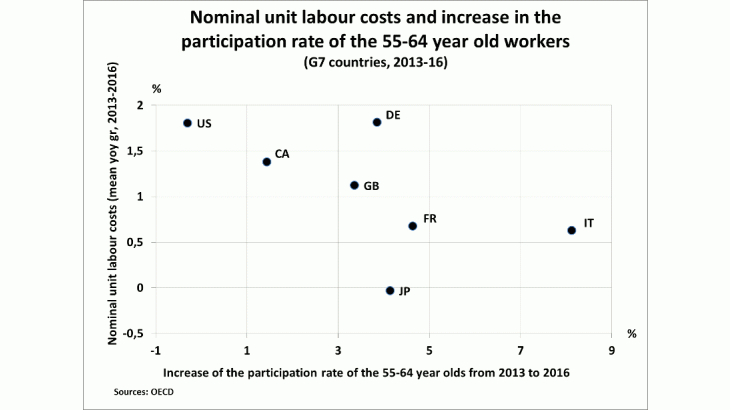Most advanced economies have two very striking features. First, inflation is stubbornly weak. Second, the participation of older workers in the labour market is rising markedly, except in the United States. We show in Mojon and Ragot (2018) that this increased participation of older workers weighs on inflation.
The post-2013 recovery in advanced economies has not yet translated into “normal” levels of inflation. Inflation remains surprisingly weak in the euro area, Japan, the United States and most other advanced economies, the United Kingdom being the exception. Core CPI inflation, the GDP-deflator inflation and nominal unit labour costs, i.e. wage inflation adjusted for labour productivity, have all remained closer to 1%, than to their pre-crisis 2% nominal anchor. In the case of the euro area, we observe low-flation in spite of the creation of over 7 million jobs since the end of the last recession in 2013. It is very tempting for some to conclude that “the Phillips curve may be broken for good” (The Economist, 1 November 2017), although the most recent estimates from Banque de France show that the Phillips curve is still alive (Rue de la Banque No. 56, February 2018).
Another major transformation in advanced economies is the ageing of baby boomers (Cahuc, Hairault and Prost, 2016). What is less known, at least to inflation analysts, is that it has led to a tremendous increase in the participation of older workers in the labour markets. For instance, 6 million of the 7 million jobs created in the euro area since 2013 are occupied by workers aged over 50. The participation rates of workers aged 55 to 64 has increased from 33% to 55% on average across OECD countries in the last decade. In Germany, it increased from around 40% until 2003 to above 70% in 2016. The United States is the only G7 economy where the participation rate of workers aged 55 to 64 has receded over the most recent years.
This major transformation of the workforce coincides with, or may be the response to, the setting up of pension reforms as well as changes of the social norms with regard to the participation of women in the labour market. These became necessary as baby-boomer cohorts approached the age of retirement. More importantly for the dynamics of inflation, the change in the composition of the workforce is akin to a major labour supply shock from ageing workers. Most likely these aim to preserve their lifetime purchasing power by postponing their retirement.
Ceteris paribus, this positive labour supply shock is likely to push down wage inflation and unit labour costs. Mojon and Ragot (2018) show that unemployment continues to have a very significant effect on wage inflation. In estimates on the panel of G7 countries, a 1% decline in the unemployment rate increases wage inflation by almost 0.5%. However, the increase in the participation of workers aged 55 to 64 is holding back wage inflation, as illustrated in Figure 1 across G7 countries: the average year-on-year increase in nominal unit labour costs, i.e. the difference between nominal wage inflation and labour productivity, between 2013 and 2016 tends to be lower in countries like Italy, Japan or France, where the rise in the rate of participation of older workers in the labour market increased the most.
We test this hypothesis in an otherwise standard Phillips curve (Mojon and Ragot, 2018). We estimate how wages react to consumer price inflation, productivity, the unemployment rate and the participation rate of workers aged 55 to 64. We find that the participation rates of the elderly have a significant negative effect on wage inflation for G7 countries, in the euro area and more broadly across OECD countries. These effects are statistically significant and sizeable. An increase in the participation rate of 10 percentage points, e.g. from 40% to 50%, lowers wage inflation by as much as 0.3% of the estimates in the G7 panel, for instance.
To some extent, it is surprising that the tensions on the labour market are not fully captured by the rate of unemployment. The evidence we report here points to a specific effect of the participation of older workers who might care more about keeping their jobs, in the years before they retire, and less about wage increases than younger workers.
